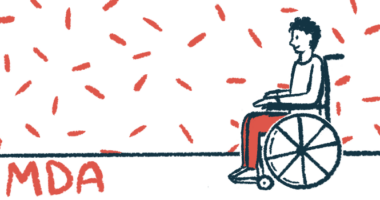#AAN2022 – Apitegromab Prompts Motor Improvements in TOPAZ Trial

Treatment with the experimental muscle-directed therapy apitegromab improved motor function for many of the children and young adults with types 2 and 3 spinal muscular atrophy (SMA) after one year in the Phase 2 TOPAZ trial.
Trial results were presented at the 2022 annual meeting of the American Academy of Neurology in the poster, “Apitegromab in Spinal Muscular Atrophy (SMA): An Analysis of Multiple Efficacy Endpoints in the TOPAZ Trial.”
Apitegromab is designed to boost muscle mass and strength in SMA patients by blocking the activation of myostatin, a protein that suppresses muscle growth. The investigational medication is being developed by Scholar Rock, which sponsored a Phase 2 clinical trial called TOPAZ (NCT03921528) to test the medicine’s safety and effectiveness in people with SMA types 2 or 3 (later-onset disease).
In the trial, 57 participants were treated for one year and were divided into three groups, or cohorts.
The first cohort included patients ages 2 and up who could not walk and had started treatment with Spinraza (nusinersen) before age 5. Participants were treated with apitegromab at one or two doses (2 or 20 mg/kg) in addition to continuing on Spinraza.
The second cohort enrolled patients ages 5 to 21 who could not walk and started on Spinraza after age 5. The third cohort enrolled patients ages 5 to 21 who could walk. In both groups, participants received apitegromab at 20 mg/kg, usually in addition to continuing Spinraza. In the third cohort, 11 patients were treated with apitegromab only (monotherapy). In all groups, apitegromab was administered via infusion into the bloodstream every four weeks.
The study’s main goal was to assess motor function using the Hammersmith Functional Motor Scale Expanded (HFMSE) in nonambulatory patients, or the Revised Hammersmith Scale (RHS) in those who could walk. Four patients who missed several scheduled doses due to COVID-19-related disruptions were not included in efficacy analyses.
In the first cohort of nonambulatory patients who started on Spinraza early in life, 10 out of 17 (59%) with evaluable data showed an increase of at least three points in HFMSE scores after one year. This represents a clinically meaningful improvement in two or three motor skills.
In the second cohort of nonambulatory patients who started Spinraza in later childhood, four out of 14 (29%) had an increase in HFMSE scores of at least three points after a year. A comparable increase in RHS scores was seen for three of 11 (27%) of the ambulatory participants in the third cohort who were treated with apitegromab alone.
Even for patients who did not experience a detectable improvement in motor scores, many had stable scores over the course of the trial. This markedly contrasts with what would typically be expected in SMA without treatment, where symptoms usually get worse as time goes on.
Both HFMSE and RHS scores indicated an inverse association between score improvements and markers of advanced disease. In other words, patients who did not have changes typically associated with more advanced SMA, such as scoliosis and contractures, tended to have greater improvements in motor function scores.
Analyses of data from the first cohort suggested that improvements were usually seen faster in patients given the 20 mg/kg dose than the lower dose.
Among nonambulatory patients, five of 16 (31%) in the first cohort and five of 14 (36%) in the second cohort had a clinically meaningful improvements in arm and hand motor function, as assessed by the Revised Upper Limb Motor (RULM).
The most common side effects reported in the trial were headache, fever, urinary tract infection, the common cold, and cough. These are generally in line with what would be expected for SMA patients on Spinraza.
“Apitegromab has the potential to be the first muscle-directed therapy to address motor function impairment affecting patients with SMA,” the researchers concluded.
Scholar Rock is now conducting a Phase 3 clinical trial called SAPPHIRE (NCT05156320), which seeks to enroll more than 200 children and young adults with SMA types 2 or 3. The study is comparing apitegromab against a placebo as an add-on therapy for Spinraza or Evrysdi (risdiplam).
The study is currently enrolling participants at Children’s Hospital of The King’s Daughters in Virginia and there are plans to open dozens more sites across the U.S. and Europe.
Note: The SMA News Today team is providing coverage of the American Academy of Neurology (AAN) 2022 Annual Meeting.







